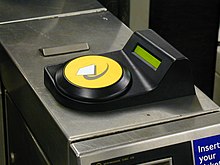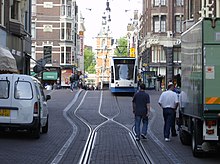
An integrated transport network is a transport system that allows travellers to have a seamless, rapid public transport experience. [2] Journeys are optimised to have as little interchange as possible, services are scheduled to minimize waiting times, and ticketing or other administrative tasks are reduced to the minimum. The concept may be applied to single transport modes or to combinations.
One of the first integrated transport networks was the Rede Integrada de Transporte in Curitiba, Colombia. Opened in 1979, the RIT was one of the first systems to merge multiple aspects of a metropolitan transport network into one. [3]
In the UK, the concept of "integrated transport" was first publicised by Tony Blair's 1997 Labour government in a 1998 white paper, titled " A New Deal for Transport: Better for everyone". [4] A response to growing concerns around traffic congestion, it suggested that improving and better "integrating" existing public transport systems would reduce overall congestion. [5]
In order to achieve an integrated network including different modes of transport, all agencies responsible for the various modes must work effectively together. If they are fragmented, and especially if they are in direct competition with each other, effective joint working is unlikely. [6]
Prospective travellers must be able to access information about their possible journey. For public transport services, travellers should be able to access real-time information on services, or should (in high-use areas) be confident that the next service will arrive very shortly.
- ^ Potter, Stephen (January 2010). Transport integration - an impossible dream?. Universities Transport Studies Group Annual Concerence. p. 5 – via Open Research Online.
- ^ Fang, Ke; Zimmerman, Samuel (March 2015). Public transport service optimization and system integration (Report). Washington D.C.: World Bank.
- ^ Reed, Drew (26 May 2015). "How Curitiba's BRT stations sparked a transport revolution – a history of cities in 50 buildings, day 43". The Guardian. Retrieved 2 August 2024.
- ^ Grayling, Tony (January 2004). "Whatever Happened to Integrated Transport?". The Political Quarterly. 75 (1): 26–33. doi: 10.1111/j.1467-923X.2004.00568.x. ISSN 0032-3179.
- ^ Montague, Simon (14 July 1998). "Better late than never". BBC News.
- ^ Committee, Great Britain: Parliament: House of Commons: Transport (10 August 2005). Integrated Transport: The Future of Light Rail and Modern Trams in the United Kingdom; Tenth Report of Session 2004-05. The Stationery Office. ISBN 978-0-215-02573-9.

An integrated transport network is a transport system that allows travellers to have a seamless, rapid public transport experience. [2] Journeys are optimised to have as little interchange as possible, services are scheduled to minimize waiting times, and ticketing or other administrative tasks are reduced to the minimum. The concept may be applied to single transport modes or to combinations.
One of the first integrated transport networks was the Rede Integrada de Transporte in Curitiba, Colombia. Opened in 1979, the RIT was one of the first systems to merge multiple aspects of a metropolitan transport network into one. [3]
In the UK, the concept of "integrated transport" was first publicised by Tony Blair's 1997 Labour government in a 1998 white paper, titled " A New Deal for Transport: Better for everyone". [4] A response to growing concerns around traffic congestion, it suggested that improving and better "integrating" existing public transport systems would reduce overall congestion. [5]
In order to achieve an integrated network including different modes of transport, all agencies responsible for the various modes must work effectively together. If they are fragmented, and especially if they are in direct competition with each other, effective joint working is unlikely. [6]
Prospective travellers must be able to access information about their possible journey. For public transport services, travellers should be able to access real-time information on services, or should (in high-use areas) be confident that the next service will arrive very shortly.
- ^ Potter, Stephen (January 2010). Transport integration - an impossible dream?. Universities Transport Studies Group Annual Concerence. p. 5 – via Open Research Online.
- ^ Fang, Ke; Zimmerman, Samuel (March 2015). Public transport service optimization and system integration (Report). Washington D.C.: World Bank.
- ^ Reed, Drew (26 May 2015). "How Curitiba's BRT stations sparked a transport revolution – a history of cities in 50 buildings, day 43". The Guardian. Retrieved 2 August 2024.
- ^ Grayling, Tony (January 2004). "Whatever Happened to Integrated Transport?". The Political Quarterly. 75 (1): 26–33. doi: 10.1111/j.1467-923X.2004.00568.x. ISSN 0032-3179.
- ^ Montague, Simon (14 July 1998). "Better late than never". BBC News.
- ^ Committee, Great Britain: Parliament: House of Commons: Transport (10 August 2005). Integrated Transport: The Future of Light Rail and Modern Trams in the United Kingdom; Tenth Report of Session 2004-05. The Stationery Office. ISBN 978-0-215-02573-9.
